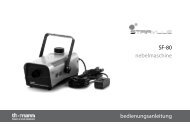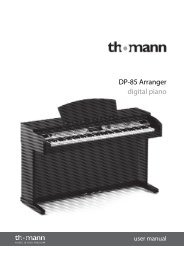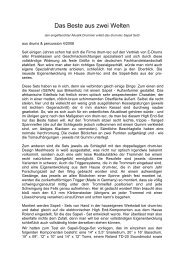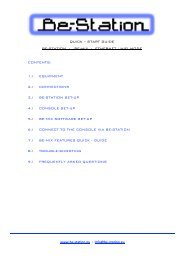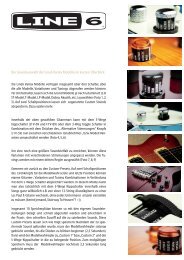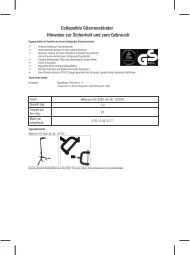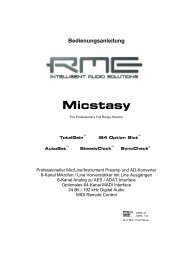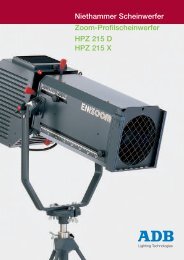Create successful ePaper yourself
Turn your PDF publications into a flip-book with our unique Google optimized e-Paper software.
9:3 Variable hihat control<br />
Overview<br />
As discussed in the last section, variable hihat MIDI recordings can be tedious to edit or quantize. Therefore, if you use this<br />
method of hihat control, it’s advisable to either make sure your takes are spot-on, or to be resigned to tedious editing operations.<br />
Of course, if you’re predominantly using BFD2 for playing live, this is not a concern.<br />
Note that BFD2’s Groove recording function automatically converts variable hihat input into standard hihat articulations which do<br />
not rely on the hihat pedal height MIDI CC values.<br />
Electronic drumkits use a MIDI continuous controller (referred to as Hihat height in BFD2) to represent the position within open<br />
and closed states of the hihat pedal. Whenever a variable tip or variable shank note is played, BFD2 plays the appropriate tip or<br />
shank articulation from those available – closed, 1/4-open, 1/2-open, 3/4-open or fully open – depending on the Hihat height.<br />
You can assign as many keys to variable tip or shank notes as you need. However, all variable tip notes share the same settings,<br />
while all variable shank notes share another group of settings. If you like, you can ‘lock’ the variable tip and variable shank settings<br />
together, if you don’t need to adjust each of them independently.<br />
There are also a number of important preferences that dictate hihat response: see section 9:4 for details.<br />
Important note<br />
BFD2 allows variable hihat control only for the hihat slot (slot 3). You may load additional hihats in other slots and trigger their<br />
articulations directly with MIDI notes, but variable hihat control is restricted to hihats loaded in the hihat slot only.<br />
Assigning variable tip and variable shank articulations<br />
Any hihat note that your electronic drumkit brain transmits should be assigned to<br />
either a variable tip or variable shank articulation, with one important exception.<br />
Almost all brains send out a ‘pedal’ note, or ‘foot-chick’ sound, when the hihat pedal is<br />
depressed fully. This note should always be mapped to BFD2’s pedal articulation.<br />
The variable tip is used for the main surface or ‘bow’ of the hihat, which should be<br />
used if you only have a single-zone hihat trigger pad. ‘Tip’ refers to the fact that the<br />
surface of the hihat is struck with the tip of the stick.<br />
The variable shank is used for the edge of the hihat, which should be used in addition<br />
to the variable tip if you have a dual-zone hihat trigger pad. ‘Shank’ refers to the<br />
fact that the edge of the hat is struck with the shank, or body, of the stick.<br />
Example: Roland TD-20<br />
A good example is the Roland V-Drums range of kits. Most of Roland’s brains send out the same set of notes for the hihat. The<br />
following table illustrates which notes to map to which articulation.<br />
Roland note<br />
Open Bow<br />
Closed Bow<br />
Open Edge<br />
Closed Edge<br />
Pedal<br />
MIDI note (note no.)<br />
A#1 ( )<br />
F#1 ( )<br />
D0 ( )<br />
A#-1 ( )<br />
G#1 ( )<br />
1<br />
BFD mapping<br />
variable tip<br />
variable tip<br />
variable shank<br />
variable shank<br />
pedal<br />
The Roland brain decides whether to send the ‘open’ or ‘closed’ note depending on the pedal controller value and a setting on the<br />
brain dictating the transition point between open and closed.<br />
This distinction is unimportant to BFD2 because it contains additional 1/4-open, 1/2-open and 3/4-open sounds.<br />
Therefore the open and closed sounds are mapped to the same variable articulation. BFD2 makes its own decisions about which<br />
actual hihat articulation to play, depending on the value of the pedal controller.<br />
The pedal note, meanwhile, chokes any playing open sound and plays the hihat pedal articulation (the ‘foot-chick’ sound).



